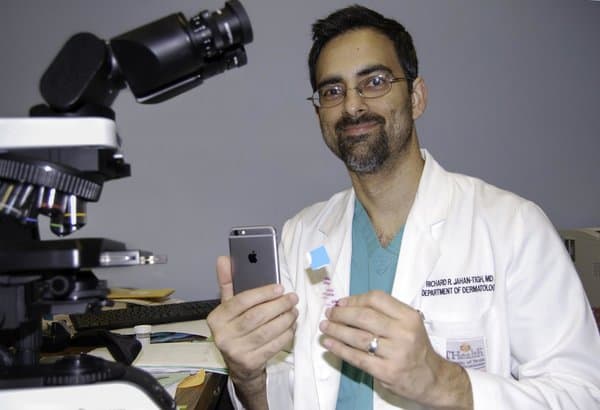Smartphone Microscopy To Lead To More Economical Cancer Detection Techniques
Dermatologists from the University of Texas Health Science Center at Houston (UTHealth) have recently devised a novel method to study cell malignancy with the help of a simple smartphone camera. Though alterations in contemporary technology have produced shocking results already, the latest research product might replace high end microscopes with smartphones that come with an inbuilt camera feature.
In underdeveloped areas, doctors suffer from poor in-lab facilities which ultimately result in wrong diagnosis. Richard Jahan-Tigh, a team member has stated that their technology best suits developing countries which lack ultra-sensitive high powered microscopes and look for an alternative solution. In the research, the team compared a modern smart phone camera with a traditional light microscope, which produced 90% accurate results in detecting non-melanoma skin cancer. Moreover, it could also detect 60% of melanoma skin cancers.

Richard Jahan-Tigh
The research finally opens the door for smartphone microscopy which leads to a futuristic detection methodology in both dermatology and pathology. Generally, a smartphone camera is made up of a 3 mm ball lens, a small sized plastic holder to keep the ball lens over the smartphone lens and a tape to connect the system together. Using the mentioned method, the detection is done in the same way a picture is focused and clicked.
At first, a skin sample is taken on a slide and placed under the focus of a smart phone camera. After that, the doctor studies the sample under investigation. Otherwise, a layman would simply click the photo and email his doctor.
Finally, it can be safely predicted that the next generation is interested in an economical approach to research where smart technology incorporation has proved to be effective. The complete research paper was published in the ARCHIVES of Pathology and Laboratory Medicine.
Source: #-Link-Snipped-#
![[IMG]](proxy.php?image=https%3A%2F%2Fssl.gstatic.com%2Fui%2Fv1%2Ficons%2Fmail%2Fimages%2Fcleardot.gif&hash=e2b0775878929b9c157e998523b20317)
In underdeveloped areas, doctors suffer from poor in-lab facilities which ultimately result in wrong diagnosis. Richard Jahan-Tigh, a team member has stated that their technology best suits developing countries which lack ultra-sensitive high powered microscopes and look for an alternative solution. In the research, the team compared a modern smart phone camera with a traditional light microscope, which produced 90% accurate results in detecting non-melanoma skin cancer. Moreover, it could also detect 60% of melanoma skin cancers.

Richard Jahan-Tigh
At first, a skin sample is taken on a slide and placed under the focus of a smart phone camera. After that, the doctor studies the sample under investigation. Otherwise, a layman would simply click the photo and email his doctor.
Finally, it can be safely predicted that the next generation is interested in an economical approach to research where smart technology incorporation has proved to be effective. The complete research paper was published in the ARCHIVES of Pathology and Laboratory Medicine.
Source: #-Link-Snipped-#
0
